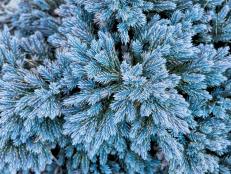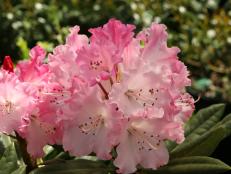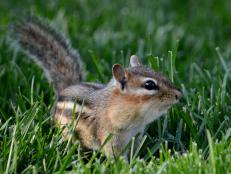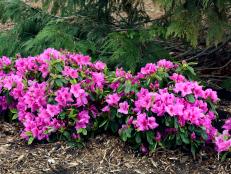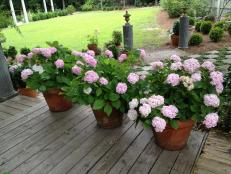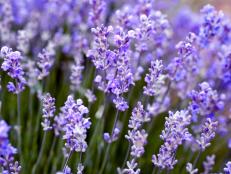How to Grow and Care for Euonymus
Whether in shrub or vine form, euonymus’s popularity is matched only by its propensity for annoying pests and disease problems. We offer solutions to common issues as well as suggestions for native alternatives to replace problematic euonymus plants.

Drive through any neighborhood and it seems like euonymus has won a popularity contest among gardeners. Nearly twenty different species and hundreds of cultivated varieties of this durable and colorful plant are grown in gardens across the country. Euonymus have been bred for different traits that include eye-catching fruit, colorful foliage, or shrubby or vining habit. Unfortunately, euonymus are plagued by severe pest and disease issues, and some non-native euonymus have become invasive in many areas, which means that gardeners should think twice before adding this versatile plant to the landscape.
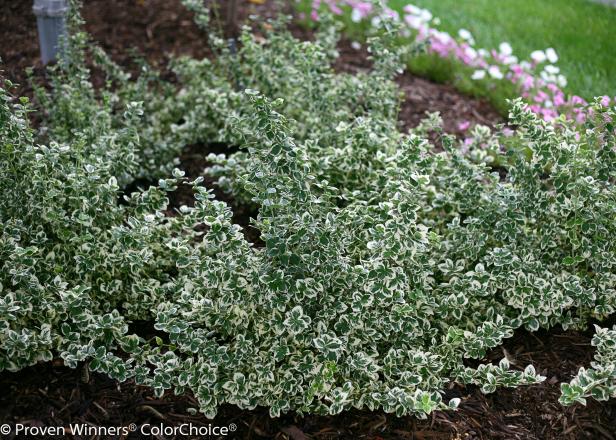
Courtesy Proven Winners® ColorChoice® Flowering Shrubs
Low-growing, evergreen euonymus needs average water and tolerates part sun to shade. This variety is called 'White Album.'
Botanical Name: Euonymus spp.
Common Name: Euonymus
Light Needs: Full sun to part shade
Hardiness Zones: Reliably 6 to 8, but varies by species
Height & Width: Differs by species
Growth Rate: Medium to fast
If you are in the market for an attractive, bulletproof shrub or groundcover, there was once a time when euonymus would have been it. Today, most ornamental species of euonymus have fallen out of favor either because of severe susceptibility to a host of pests and diseases, aggressively weedy and even invasive qualities, frequent reversions where selections with brightly colored leaves return to a green-leaved form, and overuse. With that said, not all euonymus are exactly alike. Read on to learn more about the most commonly grown euonymus species.
Burning bush (Euonymus alatus) is inconspicuous in the landscape for most of the year, but its brilliant display of fiery red fall color has made it a mainstay in many American gardens. Also known as fire bush or winged euonymus, this species may grow to 20 feet tall and wide, although there are many compact varieties available. Unfortunately, birds have spread the seeds of this species beyond the garden walls, and it has become invasive in many areas. Consider native alternatives like Virginia sweetspire (Itea virginica), oakleaf hydrangea (Hydrangea quercifolia), or blackhaw viburnum (Viburnum prunifolium). Burning bush is reliably hardy in zones 4 to 8, although zone 9 gardens in dry areas like the West Coast should be able to grow this species too.
Strawberry bush or hearts-a-bustin’ (Euonymus americanus) is native to Eastern North America from New York south to Texas and Florida. Strawberry bush can be found growing in woodlands and along streams alongside dogwood, viburnum, oak and pine. Unlike many other ornamental species of euonymus, strawberry bush has a very airy, open habit and really isn’t noticeable for most of the year. That is, until the fall when the knobby bubblegum pink fruits pop open to reveal yellow-white seeds. This species will develop into a roughly 6-foot-tall bush with a suckering habit. Hardy in zones (5)6 to 9.
Spindle Tree (Euonymus europaeus) is a small tree that has historically been grown for its showy display of pink fruit in the fall and golden or burgundy autumn foliage. The spindle tree is native to Europe and western Asia. It spreads easily by seeds, and weeding seedlings can be an annoying chore. Unfortunately, this species has escaped cultivation and become invasive in many areas. Consider native alternatives like Carolina silverbell (Halesia carolina), flowering dogwood (Cornus florida), and redbud (Cercis canadensis). Spindle tree will grow to about 30 feet tall and 25 feet wide, and it is hardy in zones 4 to 7.
Wintercreeper euonymus (Euonymus fortunei) is a versatile species with shrubby, groundcover, and vining varieties on the market. Although this euonymus typically grows as a 1-foot-tall spreading groundcover, some varieties become 6-foot shrubs. This tough plant has many selections for variegated foliage and form. Unfortunately, wintercreeper euonymus will self-seed and may out-compete native plants — especially in shady woodland situations. Consider alternatives such as cotoneaster (Cotoneaster spp.), creeping raspberry (Rubus calycinoides), bugleweed (Ajuga reptans), and native partridgeberry (Mitchella repens). Wintercreeper euonymus is hardy in zones (4)5 to 9, but may need protection from snow in northern regions
Japanese euonymus (Euonymus japonicus) was once an incredibly popular ornamental plant that was widely grown in home gardens across the country. Now this species is more commonly associated with garish fast-food landscaping. There are many cultivated varieties available including an abundance of marginally different variegated forms, however, the flush of fresh Kelly-green spring growth from plain, green-leaved selections is so attractive that it nearly makes up for the work spent battling pests and diseases during the rest of the year. Nearly, but not quite. Consider alternatives like Clerya, Distylium, or natives like anise shrub (Illicium spp.) and doghobble (Leucothoe spp.). Japanese euonymus can grow up to 15 feet tall, but is usually maintained as a much shorter hedge. Japanese euonymus has excellent salt tolerance, which means it will grow well along roadsides and in seaside plantings. Hardy in zones (6)7 to 9.
Spreading euonymus (Euonymus kiautschovicus) usually forms an 8- to 12-foot-tall shrub. Varieties are more commonly grown than the straight species, and ‘Manhattan’ (see below) is probably the most popular selection. Hardy in zones 5 to 8.
31 Flowering Shrubs for Year-Round Color 31 Photos
Help your landscape flow from late winter to fallwithout a lapse in color by choosing a variety of flowering shrubs with different bloom times, including azalea, hydrangea, buckeye, rose and more. Selections are generally organized by bloom time from early spring to late winter.
How to Use in Your Landscape
Euonymus is a tough plant that can handle any amount of light and nearly any kind of soil (except poorly drained wet sites). Shrub and tree forms tolerate hedging very well and will make excellent borders and barriers. Groundcover species are especially popular selections for difficult dry shade. Vining forms will scramble up walls and trellises, providing a colorful backdrop in sun or shade.
Although there are many bright, colorful varieties available for most ornamental euonymus species, these variegated forms can be difficult to place in the landscape. Before you add that eye-catching variegated plant to your shopping cart, it’s a good idea to pause and consider who its neighbors will be in your home garden. Euonymus with golden foliage really stand out against partners with blue or wine-colored leaves or pink flowers. Pair euonymus with white variegation with silver, blue and deep green leaved partners for a more calming effect.
How to Plant Euonymus
Plant euonymus in cool spring or fall weather. Dig a hole that is about 1.5 times the width of and the same depth as the container. Use the native soil from the hole to fill the space around the root ball. Water deeply after planting, then every few days during the first season and as needed once the roots are established.
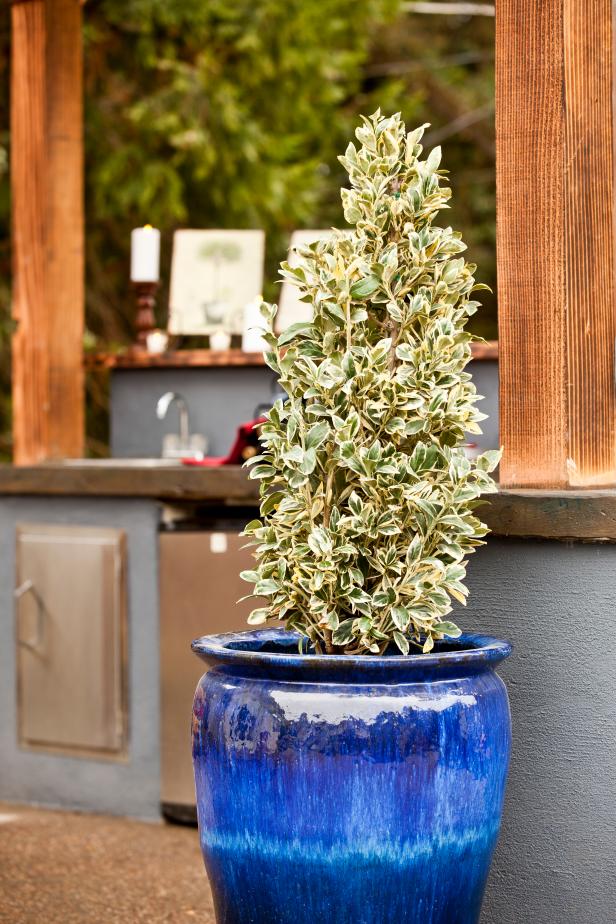
Martin Klimek/Getty Images
A golden-tipped Euonymus japonicus shrub in a large cobalt-blue flowerpot makes a bold statement in a sunny outdoor spot in this remodeled backyard.
Euonymus Care
Leaf Reversions
Plant breeders have introduced an abundance of colorful variegated euonymus. These varieties are often selected from “sports” of unusual growth from the parent plant. Breeders will take a section of the colorful sport and grow it as a rooted cutting. If they are successful, they go on to propagate many clones of the colorful sport.
It’s not uncommon to occasionally find a branch that has green leaves growing in the midst of a colorful variety, much like the original colorful sport grew out of the green-leaved parent. This green growth is called a reversion, and if left unchecked, it may eventually outcompete the variegated branches and overtake the shrub. Simply use hand pruners to remove the green branch from the plant.
Cold Damage
Although extreme cold in the winter can kill euonymus shrubs, in many areas it is more likely to damage sections of the shrub, resulting in patchy growth during the season. The best way to prevent cold damage from late freezes is to avoid pruning or fertilizing plants until the danger of frost is past. If your shrub does experience some cold damage, take a few weeks to see if affected branches will develop new leaves. If new growth doesn’t appear, it’s safe to prune out dead branches. Given time, the euonymus shrub will fill in those craters with new growth.
Health Issues
Euonymus are notorious for their high susceptibility to serious pest and disease issues. It’s unusual to find a specimen that doesn’t have at least some level of disease or an insect infestation. Healthy plants can tolerate moderate pest or disease pressure for many years, but given the right conditions, these populations of damaging insects, fungi and bacteria can explode and devastate entire plantings of euonymus. What’s more is that most of these maladies require multiple treatments to control. Rather than battling these issues with time consuming and expensive treatments, it’s better to simply grow a different plant that is not a euonymus.
Most species of euonymus are plagued by a host of health problems, including scale insects, crown gall, powdery mildew, anthracnose, leaf spots, aphids, spider mites and thrips. A few of the most common issues are described below. If you suspect that something is wrong with your euonymus, call your local county extension service for help diagnosing the problem and finding a solution.
- Euonymus scale is a fairly common issue with these popular shrubs. In severe outbreaks, entire leaves and stems will be completely coated with small white scale insects. Scale are covered with a waxy impervious coating that protects them from pesticides. The best course of action is to coat the stems and both sides of the leaves with horticultural oil. The oil will smother scale, giving the plant a little time to recover before the scale population bounces back. Be sure to follow instructions on the product label before using. Horticultural oil is effective, but heavy infestations may require entire branches to be removed and destroyed.
- Crown gall is often seen in commercial landscapes and home gardens that are maintained by a landscaping company. The bacteria responsible for crown gall is spread on tools, including hedging shears and clippers. Symptoms of crown gall include weak growth and stem dieback. If you follow the affected branches down to the soil line, you will find large woody galls growing on the stem that can be several inches wide. Crown gall is a serious disease without a cure. Stopping to sterilize tools between plants is a great way to limit the spread. The bacteria will survive in the soil for a few years after diseased plants are removed, so be sure to replace euonymus with a resistant species.
- Powdery mildew is a fungal disease that covers leaves with a white coating. Heavy infections on new growth can cause the leaves to yellow and curl. The spores can spread from leaf to leaf on water droplets from rain or sprinklers. Prevention is the best way to limit powdery mildew damage. Begin by following the spacing requirements for the variety of euonymus grown and avoid overhead irrigation. Over time, powdery mildew can become resistant to fungicide treatments. Reach out to your county extension service to discuss treatment options that work best in your area.
Popular Euonymus Varieties
Vining Groundcovers
- E. fortunei ‘Coloratus’ – lustrous green foliage transforms to plummy purple with cold winter weather; a very vigorous creeper; highly susceptible to scale insects
- E. fortunei ‘Kewensis’ – much smaller, daintier leaves than the species; leaves will become larger and the plant will fruit if allowed to climb
- E. fortunei ‘Wolong Ghost’ – eye-catching silver veins stand out against glossy, deep green leaves
Compact Evergreen Shrubs
- E. fortunei ‘Emerald n’ Gold’ – a low-growing shrub form that will grow to 2’ x 5’; may develop vines as well; gold margined leaves transform to pink-red in cold weather
- E. fortunei ‘Moonshadow’ – gold leaves with a thin, green margin; less susceptible to reversion than some other variegated types; grows to a 3’ x 5’ shrub; may develop vines as well
- E. japonicus ‘Microphyllus’ – commonly called boxleaf euonymus due to its small leaves and dense growth; a small statured variety that grows up to 3’ tall; variegated forms available; a possible alternative to boxwood
Evergreen Shrubs
- E. fortunei ‘Emerald Gaiety’ – a shrubby form that may also grow vines where branches touch the ground; mint-green leaves with white margins; grows up to 5’ x 3’
- E. japonicus ‘Chollipo’ – especially large leaves with gold margins; upright shrubby habit; grows up to 12’ x 6’
- E. japonicus ‘Green Spire’ – a tightly narrow form that works well in tight spaces; usually 6 to 8’ x 1 to 2’, although can grow to nearly 20’ tall
- E. kiautschovicus ‘Manhattan’ – produces glossy, deep green foliage; grows to 8’ x 12’
For Brilliant Fall Color
- E. alatus ‘Compactus’ – possibly the most widely grown variety of burning bush; matures to 11’ x 11’
- E. alatus ‘Fire Ball’ – more dense branching, slower growing, and better cold hardiness than ‘Compactus’; grows up to 7’ x 7’
- E. alatus ‘Little Moses’ – a dwarf selection that matures up to 4’ x 4’; produces fewer fruit than the species, at least in its youth
- E. alatus ‘Rudy Haag’ – fall color has more pink tones than the species and fewer fruit; grows extremely slowly with around 4 inches per year; reaches up to 5’ x 5’ at maturity








